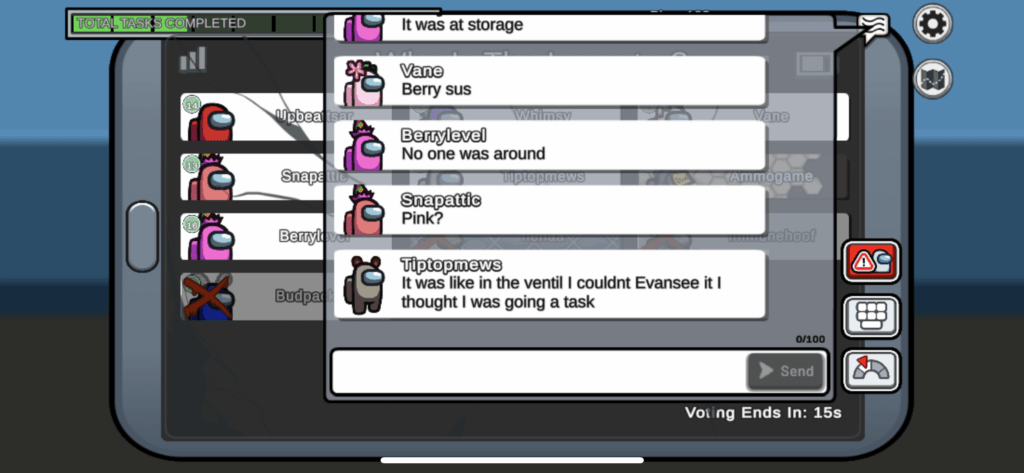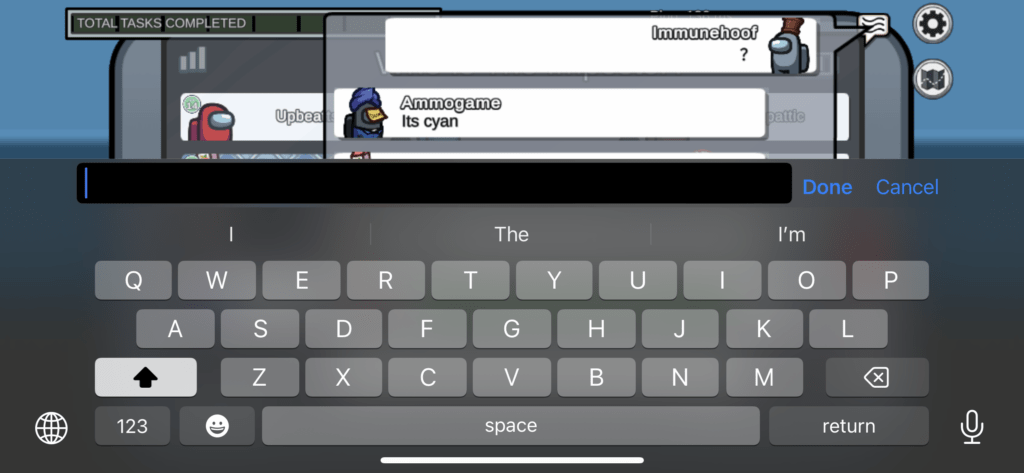Among Us emphasizes social deduction by maintaining consistent non-universal perspectives and an increasingly stressful atmosphere over time. Each player is thus forced into a position of actively observing and suspecting other players as the impostor, fostering the aesthetics of challenge and fellowship.
Among Us is an online social deduction game developed by the American game studio Innersloth, targeting teenagers and young adults (suitable for age 9+ on App Store). It can be played cross-platform on computers, phones, Switch, Xbox, etc. Players can choose to join a game alone or with friends. I playtested the classic version of the game (9 crewmembers, 1 impostor, Skeld map) alone using an iPhone 12.

fig.1 Each player’s view extremely limited
The limitation of each player’s perspective intensifies debate and allows for a space of lying, creating dynamic fellowship and constant challenge in figuring out the truth. As crewmembers or impostors, players engage in unilateral competition. The chief objective is to “outwit” the other group: crewmembers want to vote out who the impostor is while the impostor aims to kill everyone. However, throughout the game, the vision of crewmembers is extremely limited. Rules regulate that the only way players communicate is through the chat. As crewmembers, the limited information each user holds prompts them to share what they observed and strive towards the collective objective of voting out the impostor. In my playtests, crewmembers typically share info that involves mutual proofs such as “brown clear”, “I was with yellow in electric.” Sometimes when they are sure, they would write clear accusation like “red for sure.” The impostor, on the other hand, utilizes the limitation of crewmembers’ perspectives to confuse them by attributing the crimes to innocent crewmembers. Some common strategies include “pink sus” (accusing someone with no supporting evidence), “I was observed doing a task” (self-clearing). Impostors also apply special actions such as venting and sabotaging to increase efficiency in motion and killing and further confuse other players. The limited vision of each player intensifies the discussions in chat about players’ identities, contributing to the key formal element of conflict in the game.

fig.2 The chat filled with different views
The chat after a report or emergency meeting call is a key action in the game. However, with the iPhone, the keyboard for text input blocks half of the screen, making it difficult to view the ongoing discussion and type. This impacts a player’s willingness to participate in the group discussion section, resulting in a reduced experience in the key fun elements of the game – challenge and fellowship. A simple fix could be allowing audio input transcription in game, so players do not need to use the keyboard.

fig.3 Keyboard blocking chat
Furthermore, as the essential resources reduce over time, the atmosphere becomes increasingly stressful for both crewmembers and impostors. In playtests, when there are only a small number of people alive (4-5) or when the task bar is almost filled, the ’emergency meeting’ is called way more frequently than in the beginning. Both sides would like to eliminate players further through voting (vote out impostors or vote out innocent people) before the essential resources run out so the other side automatically wins. The stress further intensifies the focus on the formal element of conflict since the game is zero-sum and keeps the player more and more engaged. Towards the end of the game, the discussions become very heated, with words such as ‘must be black,’ ‘trust meeeee,’ ‘voteeeeeeeeee.’ With increasing tension and complex information sources, each user is pushed to think carefully and participate in the discussion, which leads to the main fun of the game – finding fellowship and resolving challenges.
In conclusion, the key formal element of conflict in Among Us intensifies over time due to unilateral competition among players, the zero-sum game outcome, and reduced resources. The process of completing tasks with limited perspectives allows for dynamics of mutual proving, direct accusing, honesty or deception, trust, or doubt in chat. Thus, all players could contribute actively, with the goal of ‘outwitting the impostor or all crewmembers,’ enjoying the aesthetics of forming fellowship and overcoming challenges.
Differing from social deduction games such as Mafia and Avalon, Among Us features a large map where players can move around. There is also no facilitator or “rounds.” This allows for great flexibility but could also be challenging, as sometimes many crewmembers are killed before a single voting being made. One potential change is that every time someone is killed, a meeting would automatically be triggered. Meanwhile, we would remove the cooldown time for the impostor to kill. This change in procedures would further intensify the conflict in the game because the killings can occur at a faster pace and people are forced into more discussions, which are central to the game’s aesthetics of fellowship and challenge, as discussed earlier.




